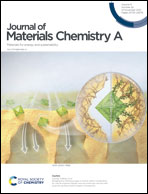A novel mechanism of controlling ultramicropore size in carbons at sub-angstrom level for molecular sieving of propylene/propane mixtures†
Abstract
The preparation of carbon materials with a molecular sieve function is very challenging due to their noncrystalline structure, but they have broad application prospects in petrochemical industries for the separation of gas mixtures. Herein, we report a novel mechanism of controlling ultramicropore size in carbons at sub-angstrom level, and with starch as a carbon source, successful fabrication of novel carbon molecular sieves (SCMSs), with a pore size distribution centered at 4.78 Å that is in-between the kinetic diameters of propylene (4.68 Å) and propane (<5.11 Å) molecules. The propylene uptake of one sample (SCMS-0.2-800) reached as high as 2.54 mmol g−1 at 298 K and 1 bar, while propane was nearly excluded thereby accomplishing complete size-sieving of propylene from propane. The propylene uptake even outperforms the crystalline porous adsorbents reported to date. In addition, by structure characterization and performance tests, we demonstrate that the formation of sieving pores is attributed to a synergistic effect of a pyrolysis pore-making process and pore-shrinking induced by high temperature. This work paves a new avenue towards the design of a new generation of carbon molecular sieve adsorbents with well-defined sub-nanopores for the effective separation of light hydrocarbon mixtures with similar sizes.



 Please wait while we load your content...
Please wait while we load your content...